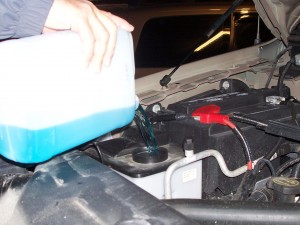How Often Should I Check My Car’s Fluid Levels?
 Other than gasoline, most drivers don’t give their car’s fluid levels a second thought on a daily basis. As we’ve said before, the key to extending the life of your vehicle is to prevent breakdowns from occurring, as opposed to fixing the problem after it happens. While some fluids aren’t as integral to maintaining peak performance, it’s a good practice to routinely inspect your fluid levels to keep them in an optimal state. Below, we explain how often you should check and change your fluid levels.
Other than gasoline, most drivers don’t give their car’s fluid levels a second thought on a daily basis. As we’ve said before, the key to extending the life of your vehicle is to prevent breakdowns from occurring, as opposed to fixing the problem after it happens. While some fluids aren’t as integral to maintaining peak performance, it’s a good practice to routinely inspect your fluid levels to keep them in an optimal state. Below, we explain how often you should check and change your fluid levels.
Regular Fluid Checks
Oil – You can check your oil level and color with the help of a dipstick. Insert a clean dipstick into the oil tube and slowly remove it. Most dipsticks will have an indicator to determine if you’re above or below the recommended amount of oil. If you’re below the minimum amount, or if the oil is black, you’ll want to have it changed.
Final verdict: Change every 5,000-7,000 miles.
Windshield Wiper Fluid – Motorists use a significant amount of windshield wiper fluid during the spring months as melting snow is constantly being sprayed up onto the windshield. Windshield wiper fluid isn’t integral to maintain peak performance, but you won’t want to be out of fluid if a passing vehicle sprays your car with mud.
Final verdict: Pop your car’s hood every month to give your windshield wiper fluid container a quick check. If it’s less than ¼ full, top it off.
Moderate Checks
Brake Fluid – A dipstick is also handy for checking your brake fluid level. Reference your owner’s manual to determine the procedure for checking your brake fluid to ensure it is at the proper level.
Final verdict: You probably only need to check your brake fluid levels once a year, and most mechanics recommend changing it every 30,000 miles or three years.
Coolant – Coolant helps make sure your engine doesn’t overheat while driving. You can easily check your coolant levels by checking under your hood and referencing your owner’s manual.
Final verdict: Coolant should be changed every 30,000 miles or every three years, whichever comes first.
Transmission Fluid – You can use your dipstick to check your transmission fluid levels, and you’ll want to have service done immediately if you realize you are running low. You’ll also want to make sure the fluid is the right color. Transmission fluid is clear pink, so if you notice any darkness in the liquid you’ll want to get it changed.
Final verdict: You should check your transmission fluid once a year, and most mechanics recommend you change it every 30,000-50,000 miles.
Longer Checks
Battery Fluid – Most batteries have a pretty good shelf life, but you should still keep an eye on the color of your battery’s fluid so you know it’s still in good shape. Most batteries have a condition indicator on the top of the battery that changes color based on the fluid quality:
- Blue/Green: Good
- Red: Add distilled water
- White: Needs to be changes
Final verdict: Change your battery every 3-5 years.
Related sources: Yahoo, NapaOnline.com
-
Winterize Your Car With These 5 Simple Steps
 Nov 11, 2014
Nov 11, 2014Two weeks ago Minnesotans were taking their boats out for one last ride on the lake, and today we’re buried beneath a few inches of snow. Hopefully you took time during the warm days to prep your car for winter driving, but if you didn’t here are five steps you’ll want to take now that […]
-
How Often Should I Check My Car’s Fluid Levels?
 Aug 21, 2013
Aug 21, 2013Other than gasoline, most drivers don’t give their car’s fluid levels a second thought on a daily basis. As we’ve said before, the key to extending the life of your vehicle is to prevent breakdowns from occurring, as opposed to fixing the problem after it happens. While some fluids aren’t as integral to maintaining peak […]
-
Reporting Potholes in Minnesota
 Mar 12, 2014
Mar 12, 2014As we noted last week, potholes can cause major damage to your car. Now that temperatures are on the rise, you’ve no doubt encountered a swarm of potholes during one of your commutes. Hopefully you’ve been able to avoid the big potholes, but that wasn’t the case for one Minnesotan whose airbags deployed when he […]




